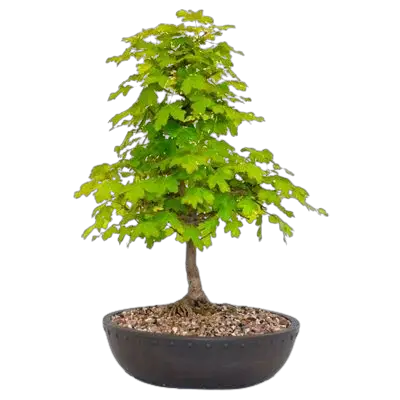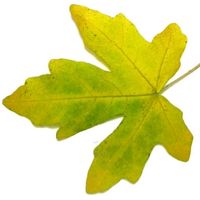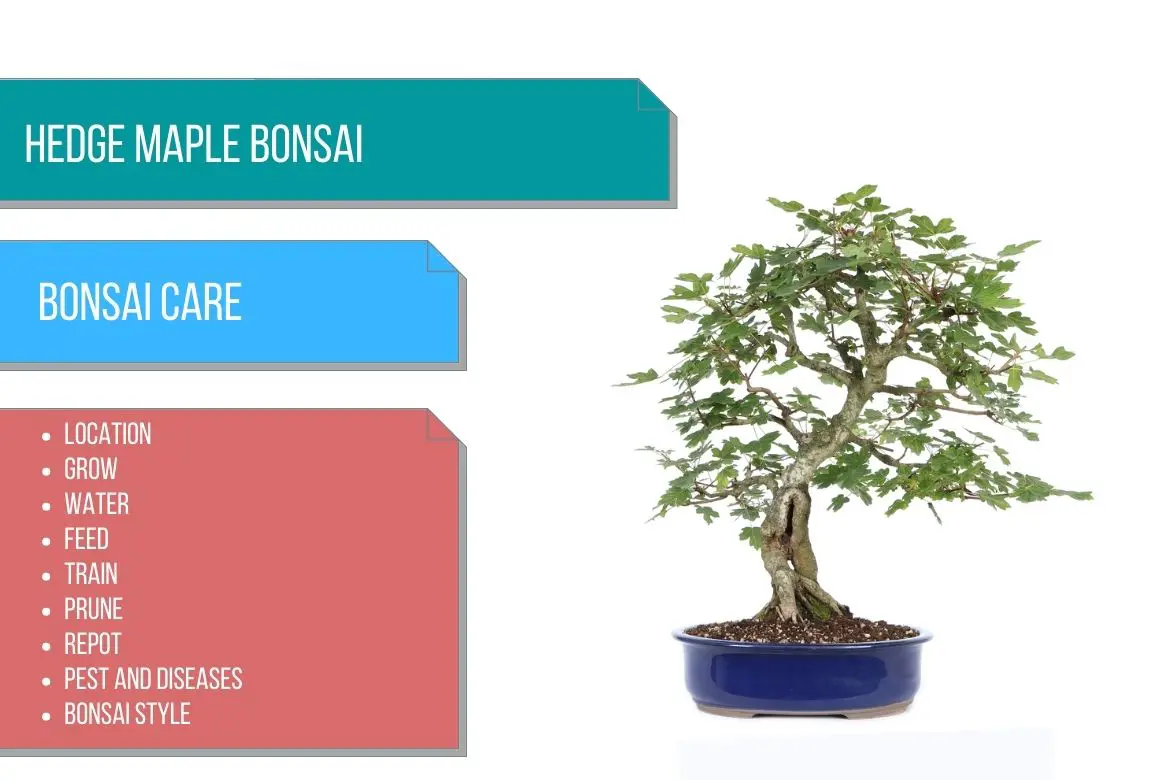
Hedge maple / Field maple
(Acer campestre)
Country of Origin : Europe and Southwest Asia
Bonsai Styles : Root over rock, informal upright, formal upright, group, twin trunk, slanting
Zone : 5
This tree, which is also known as field maple, is a hardy, small deciduous tree.
The leaves of this maple are palmate, as they are on other maples.
Due to its attractive leaf shape and beautiful autumn foliage color, hedge maple bonsai makes a pleasing bonsai. However it is not cultivated as a bonsai as frequently as its Japanese cousins – Japanese maple bonsai.
During the autumn, the leaves turn from a dark green to buttercup yellow or orange before they fall. It is distinguished from other species of maple by the leaves which have obtuse lobes, the central one often trilobate. Mature hedge maple bark grayish brown in color and develops a fissured texture.
The small leaf size, corky bark, and good response to total leaf removal makes field maple an excellent bonsai subject with good autumn color.
Acer campestre can be used for most bonsai styles, as it has a similar growth habit as Acer buergerianum (trident maple bonsai). It is generally used to make a medium sized bonsai tree. Filed maple also has a dwarf version – Acer campestre ‘Compactum’, that can also be used to make a bonsai.
Quick Tip: Because hedge maple twigs are relatively coarse, it is not suitable for smaller bonsai. However, it can be grown as an extra-small bonsai in which a single leaf resembles a mass of foliage and twigs on a branch.
In autumn, the color of the attractive leaves changes to pink, and in winter, the branch and twig structures give the trees an artistic appearance.

For all other bonsai tree species you can grow, please read : Types of bonsai trees
Best location keep Hedge maple Bonsai
Plants should be grown in full sun during the growing season in order to maintain their vibrant colors. This will give the best foliage color in fall.
Protect the bonsai by providing it with some shade on the hottest days in summer. Or else the leaves will scorch.
Winter protection is not necessary for field maples. However, extra-small Acer campestre bonsai require frost protection in the winter.
Protect the bonsai tree from strong winds. Continue reading outdoor bonsai tree care and seasonal care for bonsai trees.
Refer do bonsai trees need sunlight for more indoor and outdoor bonsai location ideas. Also, refer to sunlight requirements for indoor plants for more indoor gardening ideas.
Propagation Hedge maple
Hedge maple can be propagated by sowing seeds in winter. Continue reading Grow field maple bonsai from seeds.
Softwood cuttings can be used to propagate the tree in summer. Continue reading Grow field maple bonsai from cuttings.
Air layering can be done in the spring or summer season.
Watering Hedge maple Bonsai
You should water your Acer campestre bonsai every day during the growing season, from spring to fall.
In summer, they may need to be watered twice a day. Do not water the filed maple bonsai over the head. Water drops on the leaves will act as small lens and intensify sun rays on the leaves, resulting in burning of the leaves.
Field maple will start wilting in case it is receiving less water.
It is best to water sparingly in winter, but keep the soil evenly moist.
Read watering bonsai tree for more details about immersion technique.
Wiring Hedge maple Bonsai
Ideally, wiring should be done in the spring.
The wires should not be left on for more than six months, and they should be removed as soon as they begin to bite into the bark.
The wire marks on maple stems are unsightly, so wrapping with raffia while wiring is a good idea.
Or you can guy down the thick branches with guy wire.
Note: Wiring is best done immediately after leaf cutting. Continue reading how to wire a bonsai tree.
Pruning Hedge maple Bonsai
When to prune Hedge maple bonsai?
Despite its fast growth, this species makes an excellent bonsai that can be cut back aggressively.
During spring or summer, prune back old growth on field maples. Prune back long shoots to an appropriate dormant bud just prior to bud burst annually.
Trim back long internodes aggressively in order to minimize internodal distances.
Leaf cutting in midsummer encourages smaller leaves and good autumn color. You can also perform complete defoliation of the tree to promote growth of smaller leaves. Continue reading Pruning Field Maple Bonsai for a detailed guide.
Also refer to our detailed guide (with pictures) on how to prune a bonsai tree.
Pinching Hedge maple Bonsai
In spring, begin pinching out the growing tips of any new shoots as soon as two or three leaves have formed, doing so throughout the growing season.
Leaves on new shoots should be trimmed back to one or two pairs.
Repotting Hedge maple Bonsai
When to repot Hedge maple bonsai?
Hedge maple can be repotted every 2 to 3 years in early spring or late winter. (As soon as the new buds appear. When buds swell, but before they open).
Early spring time is a good time to repot. Repotting is also a good time to perform heavy pruning on the tree.
Repotting should also be done when the roots of the plant are pot bound.
Prune the roots up to the woody roots to remove circling and damaged roots. Do not remove more than one third of the roots.
Use a basic soil mix. Filed maple prefers alkaline soil. You can use 50:50 ratio of akadama and perlite or lava. You can also use a mix of loam, peat and coarse sand in the ratio 7:1:2.
Must Read: Bonsai Soil Recipes and how to repot a bonsai tree.
Must read : Choosing the right bonsai container
Feeding Hedge maple Bonsai
From spring to late summer, apply a general fertilizer about once a month.
The leaves will be more vibrant in color if you switch to a potassium and phosphate-rich feed in the fall.
You should not feed your tree during the winter when it is dormant. Also, reduce the feeding once you have your tree has matured and gained the desired trunk thickness. This along with yearly leaf pruning will help in twiggy growth.
Read more about bonsai fertilizer and its application.
Diseases and pest of Hedge maple Bonsai
It is often infested by aphids and mites along with scale insects, as is true of all acer trees.
If you can’t pick off enough pests by hand, apply a systemic insecticide.
Refer the in-depth guide for bonsai pest and diseases identification and treatment for more details.
Also, read best practices to keep your bonsai pest free.
Field maple bonsai care
Fine shoots can be killed by a cold wind in winter.
It is essential to protect leaves from summer winds since they can scorch them.
The roots of hedge maples are thick, fleshy, and they contain a lot of water. During prolonged freezing, water-logged roots can crack as the water inside them expands as it freezes.
You should keep the soil – and the roots – just moist during winter.
Keep the field maple bonsai indoors in a shed to prevent it from becoming waterlogged by winter rain.
What to look for when buying Hedge maple Bonsai
Despite the availability of field maples, commercially grown bonsai are a little rare.
When planted in the ground and left to grow for a few years, the species will thicken fairly rapidly as a hedging material. It is certainly one of the easiest trees to train into bonsai.
Look for scars or old stumps of old branches on the trunk.

